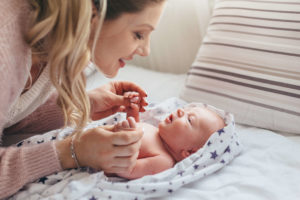All babies have blue eyes. That’s what they say. So that you are not disappointed when your darling opens his eyes for the first time and they are not blue, we explain everything about the eye color of the baby.
The moment when your baby opens his eyes for the first time is unforgettable. You should enjoy it. Whether your baby’s eyes will be the same color as yours or daddy’s depends on many factors.
The article clarifies which factors play a role in the development of the color. We also discuss whether the baby’s eye color is fixed right after birth or whether it changes.
You can not determine the eye color of the baby, but here you can read with what probability your baby gets an eye color.
Table of contents
The First Eye Color – Your Baby Has Dark Gray Eyes?
The eye color of the baby is very interesting for parents. The birth is behind you, your baby snuggles in your arms and then he opens his eyes. What an exciting moment!
Does it have your blue eyes or the brown ones of daddy? Your baby’s slightly swollen eyes open very slowly, as if they first have to get used to gravity. You look into your child’s eyes for the first time and you see … gray eyes, dark gray? Something indefinable?
Possible eye colors of a baby after birth:
- blue
- brown
- gray
- black
- dark grey
The saying “every baby has blue eyes” applies to a rather small portion of the world’s population. In Central and Northern Europe, chances are good that a baby’s eyes will be blue. But that doesn’t mean it stays that way.
To anticipate: If a baby has a brown eye color, nothing or not much changes. Babies with brown eyes only change the intensity of the color.
The situation is different with blue eyes. Here nothing is fixed yet. Not all babies have blue or brown eyes at birth. Your baby can also have dark gray, gray or black eyes after birth.
Often these eyes show a slight shimmer that seems to be like a film on the eyes. These eyes will also change.
The Color Of The Baby’s Eyes At Two Weeks
The color of the eyes is affected by the pigment melanin. The production of melanin begins just before birth. When a baby opens its eyes, they often appear blue.
The blue color is not caused by a dye, but is due to the refraction of light, just like water and sky. Actually, blue eyes are colorless.
The incident light is reflected by the iris after birth. The baby’s eyes appear blue. You can find out how the sense of sight develops here.
When Does Your Baby Change Eye Color?
If your baby is born with blue eyes, it first shows that the production of melanin has not yet started and the iris does not yet absorb light.
This was not necessary until now, because it was nice and dark in the mother’s belly. The production of melanin starts at a different time in each child. Thus, there are babies whose eyes do not change after two weeks.
Other babies show color after six weeks, and after two months it has changed slightly in intensity and tone. Then the color of the eyes after six months is different again. We are talking about nuances here.
Because you surely like to look into your baby’s eyes, you can notice these slight changes.
After three to six months, the color of the eyes is final for most babies. Some wait until their second birthday before the color becomes solid. Very rarely, the eye color changes again during puberty. This is due to hormonal reasons.
A test at the pediatrician can give you an indication if your baby will change eye color. If the iris shimmers yellowish when viewed from the side under simple light, your baby will probably have brown or green eyes.
If it continues to appear light blue, your baby will keep the eye color. You can take this opportunity to check that your baby’s pupils are behaving appropriately for his or her age and that the eyes are okay.
Here you will find an overview of what the preventive examinations at the pediatrician cover.
From Whom Does Your Baby Get Its Eye Color?
The genetic makeup of the parents determines the eye colors of babies. Maybe you remember Mendel’s laws in biology class? Mr. Mendel explained the theory of heredity using peas.
To know whether your baby will get the eye color from you or from the dad, the heredity theory gives a direction.
There are dominant genes that are more dominant. The recessive genes inherit less frequently. Each eye color has a different dominance.
Brown eyes prevail the most, while blue and gray eyes are the least dominant. They are inherited recessively. Green eyes are in the middle.
Basically, your baby gets the eye color from a genetic mix of you and the dad. For this one trait (the color of the eyes) there are two gene copies. The scientific term is diploid.
The trait determining gene is present as a double set of chromosomes. The color that prevails is the phenotype. The other characteristic is the genotype. This is not pronounced, but is present in the genetic material.
Depending on the heritability of a gene, the more dominant gene determines the color. For example, if you have brown eyes and your husband has green eyes, your child will have the genetic information brown + green.
Since brown is more dominant, it is likely that your baby will have brown eyes. However, you may have parents who also have brown and green eyes. In your genes then the color information for green and brown are stored.
You pass on the color information for green to your child and your baby will have green eyes.
The Color Of The Eyes Is A Surprise
Several genes are involved in the formation of the baby’s eye color. They influence the color intensity or the color shading.
The more you know about your family tree, the better you can determine the probability of what eye color the baby will get.
The following list gives you an overview of which combination of colors is most likely to give the baby eye color.
- blue + blue = blue
- green + green = green
- brown + brown = brown
- blue + green = green or blue
- blue + brown = brown
- green + brown = brown
Most predictions use only the parents’ eye colors. There are certainly couples who both have brown eyes and the baby has green eyes. There is no model that can accurately predict what eye color a baby will have.
The Color Of The Eyes
The color of the iris is determined by melanocytes, a specific type of cell. Melanocytes produce melanin, a pigment. This endogenous substance colors cells of the skin and eyes dark brown to black, but also yellowish and reddish.
The higher the number of melanocytes, the darker the color. If a baby has an eye color that is light, there are (almost) no cells in the iris that produce melanin.
The eyes have little or no pigment and appear blue. A slightly higher number of pigments have green eyes, most pigments brown.
How the color of the eyes actually comes about is not fully understood. The melanocytes are only one determining factor.
The Eye Color Shows The Character
Green eyes frog nature, no trace of love. Everyone knows such and similar sayings. Of course, the color of the eyes says nothing about the character of a person.
But it influences the risk of disease similar to the skin color. The level of pigmentation determines the light sensitivity of the eyes. The color-giving substance melanin reacts to light irradiation.
The brighter the eyes, the more light the eye cells absorb. In the dark north, people have brighter eyes than in the light-intensive south. Melanin protects the eyes from high light irradiation.
That’s why babies born in southern countries are protected from the sun’s strong rays by their dark eyes shortly after birth.
It is not scientifically clear whether light eyes contribute to better vitamin D supply. In light-skinned people, this connection has been established.
People with blue eyes have a 70 times higher risk than people with brown eyes to develop age-related macular degeneration. This disease significantly impairs vision and can lead to blindness.
There is no cure and only costly treatments are available. If your baby has an eye color that is light, it is important that you protect them from the sun accordingly.
The Most Common Baby Eye Color
Worldwide, most babies have brown eyes. The fact that blue eyes exist at all is attributed to a mutation that spread in Europe 6,000 to 10,000 years ago.
According to this, all people with blue eyes are descended from one person or a few people, as scientists in Copenhagen have found out.
People with blue eyes all show the same mutation of the OCA2 gene, which prevents the storage of the pigment melanin in the iris.
Some Facts About Eye Color
- 90 percent of all people worldwide have brown eyes.
- Blue eyes are exhibited by eight percent of people.
- Green eyes show two percent of the world population.
- Very rare (one percent) is iris heterochromia, in which the eyes have two different colors.
- A subtype is partial heterochromia, in which about one ring of the iris or patches of the iris are of a different color.
Presumably, this mutation was able to spread because humans reproduced within spatially narrow limits from the Middle Stone Age (9,500 to 4,500 B.C.) until the 19th century. Couples with blue eyes each passed them on to their offspring.
With the wave of emigration to America, blue eyes reached the USA and Canada. Until the time of this mutation, all people had brown eyes. In Estonia, 99 percent of people have blue eyes, in Germany about 30 percent.
Although green eyes genetically prevail over blue eyes, they are rarer. A special form of green-brown eyes are so-called “Hazel” eyes.
These show different colors (brown, green, blue with golden spots or dots) in different light situations.
The refraction of light in the second layer of the iris is responsible for this. In Germany this term is unknown. People with Hazel eyes can not determine what color their eyes have.












